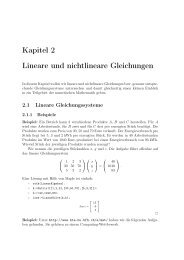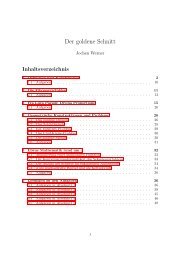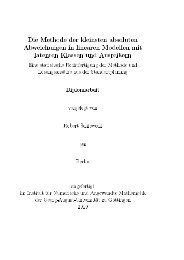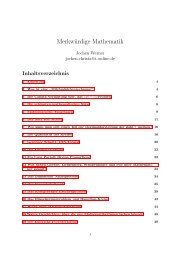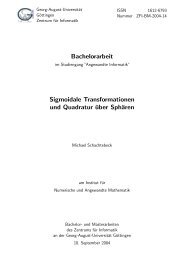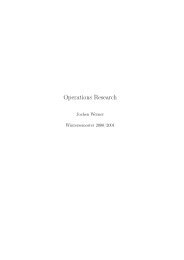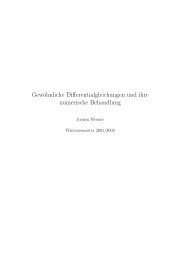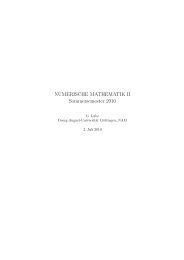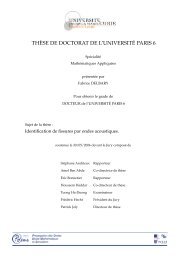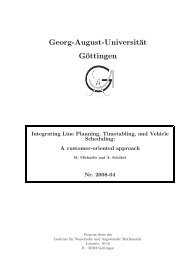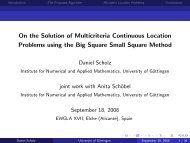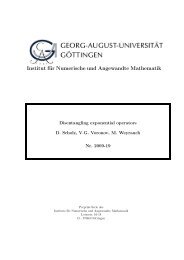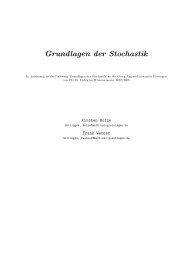BAIL 2006 Book of Abstracts - Institut für Numerische und ...
BAIL 2006 Book of Abstracts - Institut für Numerische und ...
BAIL 2006 Book of Abstracts - Institut für Numerische und ...
You also want an ePaper? Increase the reach of your titles
YUMPU automatically turns print PDFs into web optimized ePapers that Google loves.
J.-S. LEU, J.-Y. JANG, Y.-C. CHOU: Evaporating cooling <strong>of</strong> liquid film along an<br />
inclined plate coverd with a porous layer<br />
✬<br />
✫<br />
Evaporating cooling <strong>of</strong> liquid film along an inclined plate covered with a<br />
porous layer<br />
ABSTRACT<br />
Jin-Sheng Leu<br />
Department <strong>of</strong> Mechanical Engineering<br />
Air Force <strong>Institut</strong>e <strong>of</strong> Technology<br />
Kaohsiung, Taiwan 82042<br />
Jiin-Yuh Jang* and Yin Chou<br />
Department <strong>of</strong> Mechanical Engineering,<br />
National Cheng-Kung University<br />
Tainan, Taiwan 70101<br />
The purpose <strong>of</strong> this work is to evaluate the heat and mass enhancement <strong>of</strong> liquid film<br />
evaporation by covering a porous layer on the plate (as shown in Fig. 1). There is an extensive<br />
literature for liquid film evaporating flow based on simplified 1-D and 2-D mathematical models.<br />
Wassel and Mills [1] illustrated a 1-D design methodology for a counter-current falling film<br />
evaporative cooler. Yan and Soong [2] presented their numerical solution for convective heat and<br />
mass transfer along an inclined heated plate with film evaporation with more rigorous treatments <strong>of</strong><br />
the equations governing the liquid film and liquid-gas interface. The complete two-dimensional<br />
bo<strong>und</strong>ary layer model for the evaporating liquid and gas flows along an inclined plate was studied<br />
recently by Mezaache and Daguenet [3]. Their parametric study focused on the effects <strong>of</strong> inlet<br />
conditions such as gas velocity, liquid mass flow rate and inclined angles and their interaction with<br />
both isothermal and heated walls. Zhao [4] studied the coupled heat and mass transfer in a stagnation<br />
point flow <strong>of</strong> air through a heated porous bed with thin liquid film evaporation.<br />
Until now, there seems to be no related theoretical analysis to evaluate the feasibility <strong>of</strong><br />
utilizing porous materials for the heat transfer enhancement <strong>of</strong> falling liquid evaporation. This has<br />
motivated the present investigation. The present study analyzes the liquid film evaporation flow along<br />
a vertical isothermal plate covered with a thin liquid-saturated porous layer. Liquid and gas streams<br />
are approached by two coupled laminar bo<strong>und</strong>ary layers. The non-Darcian inertia and bo<strong>und</strong>ary effects<br />
are included to describe the hydraulic characteristic <strong>of</strong> the liquid-saturated porous medium. Then, the<br />
governing equations (tabulated in Table1) are discretized to a fully implicit difference representation,<br />
in which the upwind scheme is used to model the axial convective terms, while second-order central<br />
difference schemes are employed for the transverse convection and diffusion terms. Newton<br />
linearization procedure is used to linearize the nonlinear terms <strong>of</strong> governing equation.The numerical<br />
solution is obtained by utilizing a fully implicit finite difference method and examined in detail for the<br />
effects <strong>of</strong> porosity ε, porous layer thickness δ, ambient relative humidity φ and Lewis number Le on<br />
the average heat and mass transfer performance.<br />
The numerical results conclude that the latent heat flux is the dominant mode for the<br />
present study. The cases for lower ε and δ would produce higher interfacial temperature and mass<br />
concentration, and thus enhance the �heat and mass transfer performances across the film interface. The<br />
influence <strong>of</strong> ε on the Nusselt number (Nu) and Sherwood number(Sh) is gradually more significant<br />
as δ is increased. An applicable range <strong>of</strong> porous layer thickness δ=0.001~0.005 is suggested for the<br />
practical application (as shown in Fig. 2). For the effect <strong>of</strong> ambient relative humidity φ, it is observed<br />
that a lower φ leads to a higher Nu but lower Sh. However, the influence on Nu and Sh appears to be<br />
less significant than those <strong>of</strong> ε and δ. In addition, as the Lewis number is increased(Le>1), a larger<br />
heat transfer rate is achieved.<br />
* Pr<strong>of</strong>essor, author to whom correspondence should be addressed<br />
Tel: 886-6-2088573 Fax: 886-6-2342232<br />
1<br />
E-mail: jangjim@mail.ncku.edu.tw<br />
Speaker: JANG, J.-Y. 106 <strong>BAIL</strong> <strong>2006</strong><br />
✩<br />
✪



